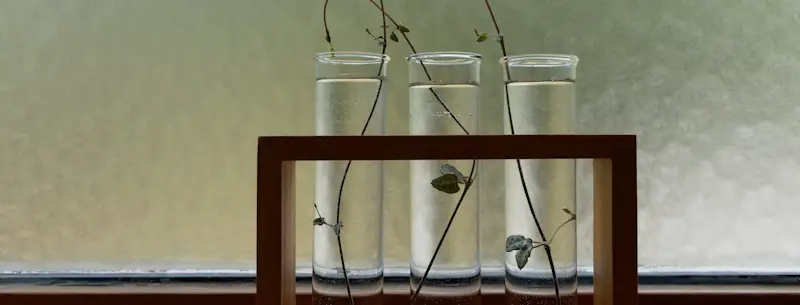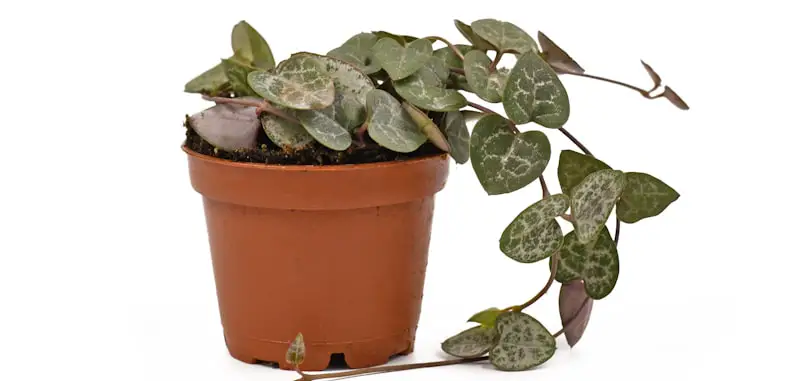With its heart-shaped flowers blooming on slender vines that could eventually linger for miles, this plant makes the perfect hanging plant. However, what happens when your Ceropegia woodii, also called a string of hearts, grows a little overly long or unkempt? Simple propagation enables you to reduce the vines and is the answer to these problems.
There are diverse methods available for propagating a string of hearts. A string of hearts can be propagated by cutting in soil, butterfly method cuttings, rooting cuttings in water, propagating from seed, laying strands on soil, propagating by using tubers, and looping strands back in the soil.
Take additional care of your plant for a few weeks after it has been planted or has become rooted in the soil. The subsequent care is identical to that of the mother plant. Although pruning your parent plants to propagate could be stressful, propagating plants is enjoyable.
How To Propagate Variegated String Of Hearts?
Ceropegia Woodii variegata, often known as the variegated string of hearts, is a special plant for creative gardeners looking for something other than the standard green in their plants. The string of hearts is one of the simplest plants to propagate. Below are some of the ways to propagate a variegated string of hearts.
Propagating From Seed
The heart chain blossoms; you could encounter strange blooms throughout the year. The development of seed pods depends on pollination. Your heartstring may bloom if it is joyfully chugging along and expanding well. The little, almost phallic-shaped blooms are not particularly attractive, but they can provide seeds that can be used to cultivate new plants.
Wait until the seed pots open naturally and the seeds start to spill out. Gather the seeds, then plant them in a moist environment; get soil specially mixed for germinating. Prepare a seedling tray; sow the seeds after adding the succulent soil mixture to the containers.
To prevent them from blowing away, carefully cover 1-2 seeds in each container with soil using tweezers. Use a spray bottle to moisten the soil while being careful not to disturb the seeds. Keep in a cozy, well-lit area; ensure the soil is damp but not soggy.
Given how prolific Ceropegia woodii seeds are, it should not take long until you observe the first indications of life. Once the seedlings emerge from the earth, the humidity cover can be removed.
Tuber Propagation
You can notice aerial tubers growing along the strands, depending on how old your plant is and how prolonged it has been in your care. They resemble stone potatoes and can be buried in the ground to sprout new vines. Keep the tuber intact to the vine and drive it into the ground for the best results.
You must always keep the soil moist; the tubers should have taken root after a few weeks, at which point you can cut the parent plant’s vine. Gently separate any bulbs that are buried or growing above the soil. Although it is not necessary, they almost certainly have roots attached.
Snip the vine just above any aerial tubers to harvest them; leave the stems and leaves on the bulbs alone; even if they fall off, it would still function. Place each tuber’s bottom half in the ground and bury the root-covered side.
Place any remaining vines or leaves above the soil level if they are still connected. Occasionally spray the upper surface in which the tuber is planted to keep it just barely wet. To root, they require a lot of warmth and strong light.
By Division
It is simple to grow a string of hearts by division, and this method is typically the quickest and most effective approach to growing new plants. Several approaches can be taken. The aerial tubers that grow along the vines can be used, the root ball can be divided, and individual soil-based bulbs can be separated.
Dividing the rootball into parts with multiple tubers is the easiest way to produce larger, fuller plants. Select a pot that is spotless, has sufficient drainage holes, and is comparable to the size of the portion you intend to take. The new container’s bottom should include a layer of well-draining or ordinary potting mix.
Remove the rosary vine from the pot and chop it up into a few substantial pieces. Be delicate and gentle with it because untangling the roots and vines can take some time. Put each division inside a pot and cover the area surrounding it with dirt; bring them back to a well-lit area where there is indirect light.
How To Propagate String Of Hearts In Water
Among the most popular techniques where new vine roots appear quite quickly is water propagation. Water propagation is enjoyable because you can constantly monitor the condition of the roots and their rate of growth. Take a few vines off the mother plant; you must have at least one node immersed in water since the roots will develop from the stems where the leaves grow.
Remove the leaves out from the vine’s water-submerged end by cutting them off. Ice should not be present in the water; water should be poured onto the propagation tube. Place them in a warm location with lots of bright lighting after submerging them in water; in a week or two, you may notice the roots forming; however, it may take longer.
Check them frequently; the time of year and the growing environment all play a role in this. You are doing great as long as the cord is not decaying; change the water around every two weeks or whenever you see it getting murky. Once the roots begin to expand, they often do so quickly, and you will notice a considerable difference virtually every day.
You can bury your string of hearts in the ground once the roots are approximately 1 cm long. Add moist planting dirt to the pot; make a hole, and insert the vine of the string of hearts. Use earth to cover; you should enclose the propagated plant in a transparent container for about a week.
How To Propagate String Of Hearts From Cutting
The cuttings should be prepared in the same manner as for water propagation; remove the leaves by cutting the string. Pick a 3 to 4 inches piece of the vine with sound leaves attached. As an alternative, you can divide a longer portion into several parts. Put the strands in freshly prepared potting soil, moisten it with water, and then plant it.
Strip all of the leaves from the cutting’s lowest two inches; for it to function, there has to be at least a single exposed node. Additionally, because it will simply rot, cut off the excess empty section of stem that is located below the bottom node. Pinch off any buds or blossoms that may be present.
The leafless node needs to be in the ground but not too deep; before planting the strand in soil, you can give it a quick dip in rooting hormone, but it is not necessary. Put the container in a clear bag or cage to create a high humidity environment for your plant; the soil should always be moist, so check it frequently. The plant should begin to root in a few weeks.
Final Thoughts
Even though you can propagate the plant all year long if you keep it indoors, the growing season is the ideal time to do it. When you propagate in the springtime, your freshly propagated plant will benefit the most because it has the entire planting season ahead of it. Any of these techniques can be used very effectively to spread a string of hearts. If you give it a shot, you will discover how simple it is to grow your collection.
Victoria is the owner and main author of hobby plants. She loves spending her free time in her garden planting and taking care of her plants. Victoria hopes you enjoy the content here!
